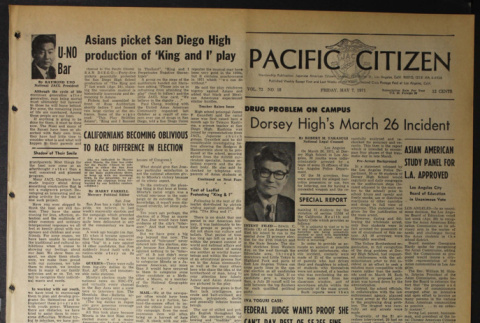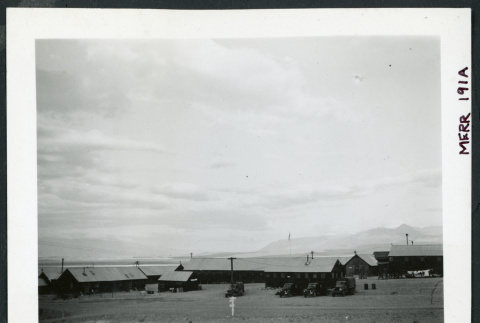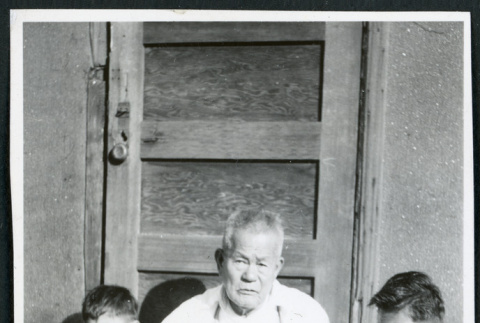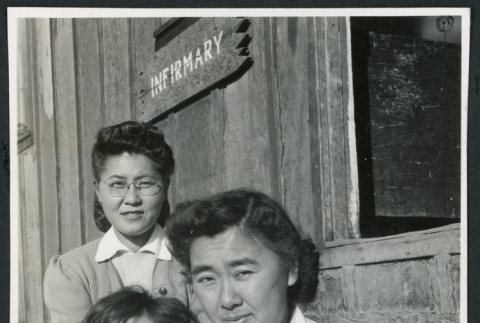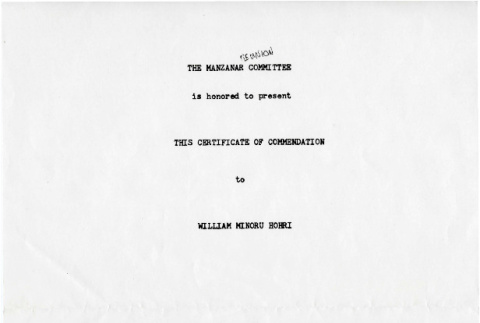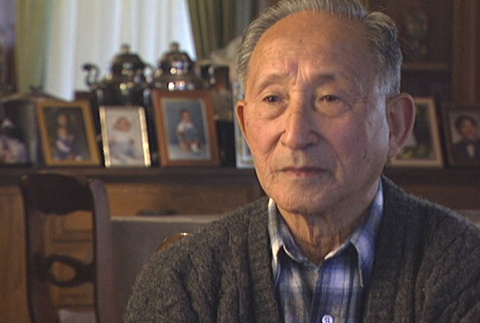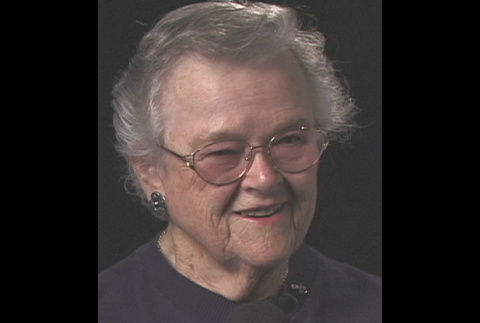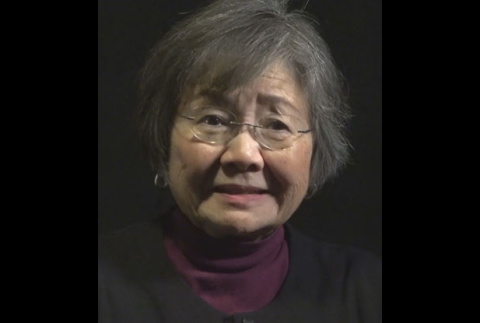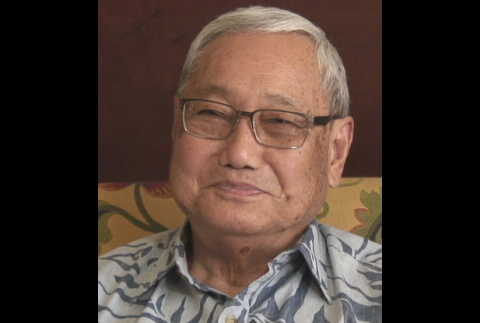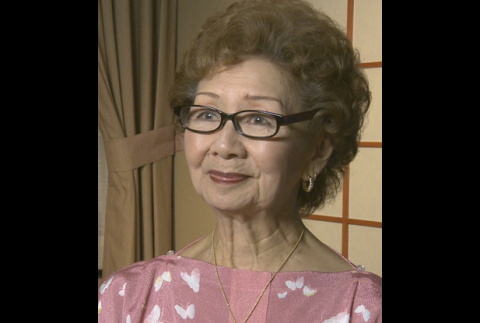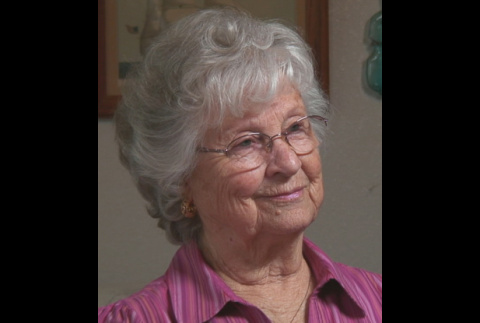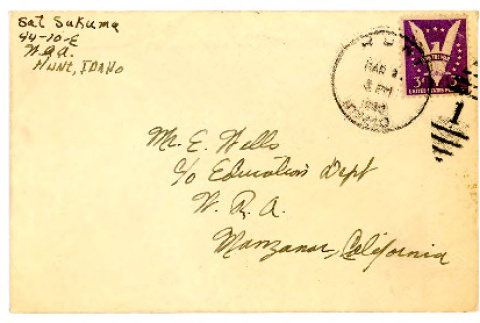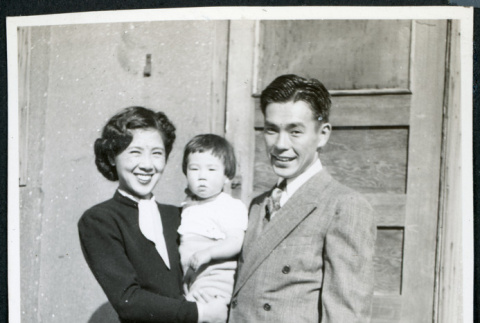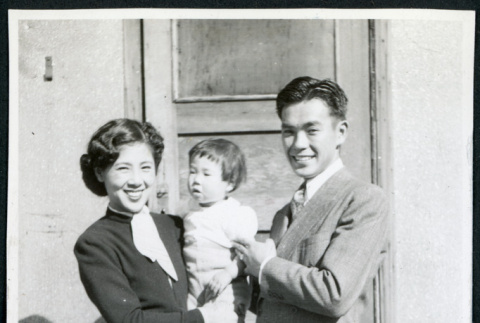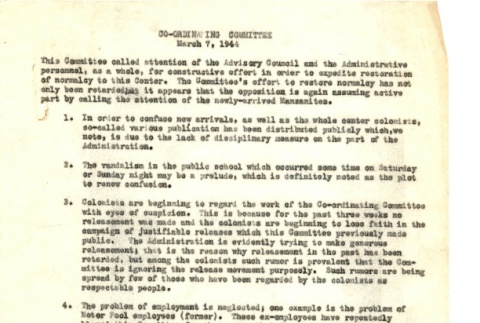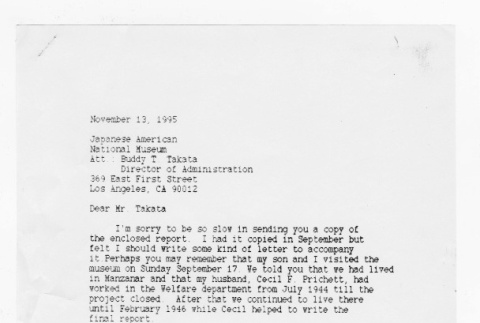1941 items
1941 items

vh
Constance Yamashiro Interview (ddr-chi-1-18)
Sansei female. Born May 6, 1938, in Los Angeles, California. During World War II, sent to the Manzanar concentration camp, California, with her parents and grandparents. After leaving camp, the family resettled in Chicago, Illinois, where her mother did factory work.
(This material is based upon work assisted by a grant from the U.S. Department of …

Narrator Shirley Nagatomi Okabe
Nisei female. Born February 7, 1937, in San Francisco, California. Grew up in San Francisco, where father was a prominent Buddhist minister. During World War II, removed to the Tanforan Assembly Center, California, and the Manzanar concentration camp, California. After leaving camp, returned to California. Father was instrumental in the planning and building of the cemetery …
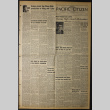
doc
Pacific Citizen, Vol. 72, No. 18 (May 7, 1971) (ddr-pc-43-18)
Selected article titles: "Drug problem on campus: Dorsey High's March 26 Incident" (p. 1), "Asians picket San Diego High production of 'King and I' play" (p. 1), "Californians becoming oblivious to race difference in election" (p. 1), "500 Sansei win California state scholarship award" (p. 1), "JACL represented at American Immigration and Citizenship confab" (p. 2), …
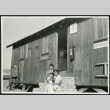
img
Photograph of two women an a young child posing in front of the infirmary at Cow Creek Camp in Death Valley (ddr-csujad-47-136)
Photograph of two women an a young child posing in front of the infirmary at Cow Creek Camp in Death Valley National Park. Incarcerees were transferred to the former Civilian Conservation Camp after the Manzanar Riot for their own protection. See this object in the California State Universities Japanese American Digitization project site: ecm_merritt_0221

img
Photograph of Cow Creek Camp in Death Valley (ddr-csujad-47-348)
Photograph of Cow Creek Camp in Death Valley National Park. Incarcerees were transferred to the former Civilian Conservation Camp after the Manzanar Riot for their own protection. The photograph is taken from the east looking west toward the Panamint range. See this object in the California State Universities Japanese American Digitization project site: ecm_merritt_1191
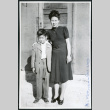
img
Photograph of Mrs. Moroika and son Ned posing in front of a door at Cow Creek Camp in Death Valley (ddr-csujad-47-128)
Photograph of Mrs. Moroika and son Ned posing in front of a door at Cow Creek Camp in Death Valley. Incarcerees were transferred to the former Civilian Conservation Camp after the Manzanar Riot for their own protection. See this object in the California State Universities Japanese American Digitization project site: ecm_merritt_0213
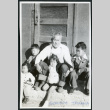
img
Photograph of Grandpa Tayama surrounded by four children in front of a door in Cow Creek Camp in Death Valley (ddr-csujad-47-131)
Photograph of Grandpa Tayama surrounded by four children in front of a door in Cow Creek Camp in Death Valley National Park. Incarcerees were transferred to the former Civilian Conservation Camp after the Manzanar Riot for their own protection. See this object in the California State Universities Japanese American Digitization project site: ecm_merritt_0216
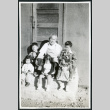
img
Photograph of Grandpa Tayama surrounded by five children in front of a door in Cow Creek Camp in Death Valley (ddr-csujad-47-132)
Photograph of Grandpa Tayama surrounded by five children in front of a door in Cow Creek Camp in Death Valley National Park. Incarcerees were transferred to the former Civilian Conservation Camp after the Manzanar Riot for their own protection. See this object in the California State Universities Japanese American Digitization project site: ecm_merritt_0217

img
Photograph of two women an a young child posing in front of the infirmary at Cow Creek Camp in Death Valley (ddr-csujad-47-135)
Photograph of two women an a young child posing in front of the infirmary at Cow Creek Camp in Death Valley National Park. Incarcerees were transferred to the former Civilian Conservation Camp after the Manzanar Riot for their own protection. See this object in the California State Universities Japanese American Digitization project site: ecm_merritt_0220
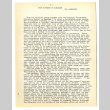
doc
What happened at Manzanar (ddr-csujad-19-70)
This is an article from the magazine "Common Ground," volume III, no. 3, spring 1943, which discusses about the first violent outbreak at the Manzanar incarceration camp on the eve of the first anniversary of the Pearl Harbor attack. See this object in the California State Universities Japanese American Digitization project site: WRA_02-22_01
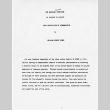
doc
Certificate of Commendation to William Minoru Hohri (ddr-csujad-24-47)
William Minoru Hohri was honored by the Manzanar Committee for his leadership of the class action lawsuit Hohri v. U.S., a civil suit filed against the U.S. government demanding compensation for Japanese Americans incarcerated during World War II. See this object in the California State Universities Japanese American Digitization project site: chi_02_006
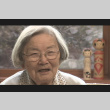
vh
Fumiko Hayashida Interview (ddr-densho-1001-1)
Nisei female. Born January 21, 1911, in Winslow, Washington. Grew up in Japan and the Fletcher's Bay area of Bainbridge Island, Washington. Member of the first group of Japanese Americans to be forcibly removed from their homes and incarcerated. Incarcerated at Manzanar concentration camp, California, and Minidoka concentration camp, Idaho, while pregnant and caring for two …

vh
Harry Ueno Interview (ddr-densho-1002-7)
Nisei male. Born April 14, 1907, in Pauilo, Hawaii. Lived in Japan from 1915 to 1923, and settled on the mainland upon his return to the United States. Was married in 1930, and was removed along with family to Manzanar concentration camp, California, during World War II. While in Manzanar, organized the Mess Hall Workers Union. …

Narrator Martha Shoaf
White female. Born June 28, 1919, in Los Angeles, California. Fourth grade teacher at Manzanar concentration camp, California.

Narrator Fumino Tsuchiya-Knox
Sansei female. Born February 20, 1945, at the Manzanar concentration camp, California. Prior to the war, her father, an Issei, was a curator at the Harding Museum in Chicago. After the bombing of Pearl Harbor, her parents decided to volunteer to go early to Manzanar to help set up the camp. After leaving Manzanar, the family …

Narrator George Kiyo Wakatsuki
Nisei male. Born December 10, 1931, in Guadalupe, California. Grew up in Santa Monica, California, where father was a fisherman. Family moved to Terminal Island, California, just before World War II. During the war, removed to the Manzanar concentration camp, California. Served in the navy during the Korean War. The family's wartime experiences were chronicled in …

Narrator Mary Kageyama Nomura
Nisei female. Born September 29, 1925, in Los Angeles, California. Lost both parents at an early age, and was raised by older siblings as part of a large family. During World War II, removed to the Manzanar concentration camp, California. Trained in music from childhood, became known as the "Songbird of Manzanar," performing in camp. After …

Narrator Phyllis Fechner
White female. Born July 8, 1930, in Fullerton, California. Grew up in Bishop, California. Remembers vising the Manzanar concentration camp, California, during World War II.

doc
Letter from Satoru Sakuma to Harry Bentley Wells, March 3, 1942 (ddr-csujad-48-55)
Letter and envelope from Sat Sakuma to Harry Bentley Wells describing the journey from Manzanar to Minidoka. He also describes the conditions at Minidoka when they arrived and in his opinion a lacking education system. Transcription is found in item: ecm_wells_9055. See this object in the California State Universities Japanese American Digitization project site: ecm_wells_0055

img
Photograph of Jean and Togo Tanaka with daughter Iye posing in front of a door in Cow Creek Camp in Death Valley (ddr-csujad-47-130)
Photograph of Jean and Togo Tanaka with daughter Iye posing in front of a door in Cow Creek Camp in Death Valley National Park. Incarcerees were transferred to the former Civilian Conservation Camp after the Manzanar Riot for their own protection. See this object in the California State Universities Japanese American Digitization project site: ecm_merritt_0215

img
Photograph of Jean and Togo Tanaka with daughter Iye posing in front of a door in Cow Creek Camp in Death Valley (ddr-csujad-47-129)
Photograph of Jean and Togo Tanaka with daughter Iye posing in front of a door in Cow Creek Camp in Death Valley National Park. Incarcerees were transferred to the former Civilian Conservation Camp after the Manzanar Riot for their own protection. See this object in the California State Universities Japanese American Digitization project site: ecm_merritt_0214
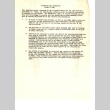
doc
Tule Lake Co-ordinating committee notes (ddr-csujad-2-27)
Meeting notes of incarceree led Tule Lake Camp government. Describes a desire to "return to normalcy" after unrest in camp including various publications, vandalism, the arrival of Manzanar transfers, lack of employment, and no prisoners being released for three weeks from the army stockades. See this object in the California State Universities Japanese American Digitization project …

doc
Manzanar Free Press Vol. 6 No. 85 (April 14, 1945) (ddr-densho-125-329)
Selected article titles: "Manzanar Saddened by President's Death" (p. 1), "Message by Block Managers Assembly Chairman" (p. 1), "Property Receiving, Shipping Warehouse Moves to Mess Two" (p. 1), "Insurance Not Available to Japanese" (p. 1), "War Correspondent Writes of Nisei Soldiers' Problems" (p. 1), "Four Additional WRA Offices to Open in Southern California" (p. 1), "Students …
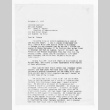
doc
Letter to Buddy T. Takata (ddr-densho-402-3)
Correspondence from Marie R. Prichett to Buddy T. Tanaka, Director of Administration at the Japanese American National Museum. She references a report of activities of the Welfare Department that her husband Cecil F. Prichett wrote while working in the Welfare Department in Manzanar from July 1994 until the project closed. She also mentions a professor from …
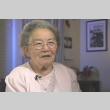
vh
Fumiko Hayashida Interview (ddr-densho-1000-15)
Nisei female. Born January 21, 1911, in Winslow, Washington. Grew up in Japan and the Fletcher's Bay area of Bainbridge Island, Washington. Member of the first group of Japanese Americans to be forcibly removed from their homes and incarcerated. Incarcerated at Manzanar concentration camp, California, and Minidoka concentration camp, Idaho, while pregnant and caring for two …


